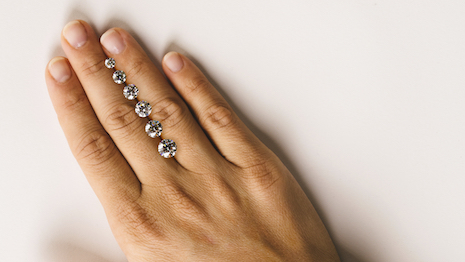NEW YORK – The Diamond Producers Association is working to build an emotional story around diamonds by leveraging the stone's history and place in culture.
During a keynote at Initiatives in Art and Culture’s Fashion and Design Conference on Nov. 15, an executive from the organization explained how he views diamonds as a type of art, since art is all about light and proportion. Through its marketing campaigns, the DPA has sought to enlighten consumers on diamonds’ 3 billion year timeline and the rarity of finding these stones.
"Billions of years old, diamonds are the oldest objects that most of us will ever touch, let alone own," said Grant Mobley, trade lead at the Diamond Producers Association.
"Just like fine art, a diamond is timeless and enduring," he said. "The beauty of a diamond can transcend generations, becoming part of the wearer’s own story and family history when passed down as a cherished heirloom."
Diamond discovery
According to Mr. Mobley, diamonds are a “rare beauty.” The stones were formed billions of years ago under the earth’s surface, and might not have been discovered if it were not for volcanoes that pushed them closer to the surface.
All of the diamonds that are one carat or larger that are mined in a year could fit into an exercise ball.
Increasing the rarity of diamond jewelry, only about 30 percent of stones are deemed gem quality. The remaining 70 percent are used for industrial purposes.
There has also been no major deposit discoveries in recent history, with many of the mines going back decades.
No two diamonds are identical, with many featuring imperfections, or inclusions. These are typically caused by another material that was embedded in the stone besides carbon.

De Beers' mining site in Canada. Image credit: De Beers
Since natural diamonds are all different, Mr. Mobley compares them to people.
Diamonds are also intrinsically connected to the human body, since the first person wore the stone centuries ago.
Early after their discovery, no one could figure out how to cut diamonds, since they are such a strong material. The name diamond actually comes from the Greek word “adamas,” which means unbreakable.
Diamonds have also had symbolic significance. Beyond engagement rings, diamonds are the birthstone of April, and people used to believe that the stones had healing properties.
DPA recently touted the lengthy process behind natural diamonds in the latest chapter of its “Real is Rare, Real is a Diamond” campaign aimed at a millennial audience.
Launched Oct. 7, “The Diamond Journey” chronicles the roles that diamonds have played throughout human history, as a sign of affection or an heirloom. An alliance between the leading mining companies, DPA has been working to promote and differentiate natural stones from lab-grown diamonds through storytelling (see story).
DPA's "The Diamond Journey"
Mined versus manmade
Colored diamonds are even rarer than white diamonds, representing about 0.4 percent of all graded diamonds. Blue diamonds, which seem to come from deeper below the surface due to the presence of boron, are only 0.1 percent of colored diamonds.
According to the Natural Color Diamond Association, there are 100 Picasso paintings on the market for every natural blue diamond.
While record-setting diamond sales dominated the headlines in 2017, it is colored gemstones' huge projected growth that will be of special interest to investors.
Researchers at Fura Gems estimated that the global market for gems could reach $10 billion in the next decade, while the Pink Star diamond was sold in 2017 for $71 million, setting a record for the most expensive jewel ever purchased. These data points show that not only are the markets for gems and colored diamonds healthy, they are also prime for wealthy investors to pour their money into (see story).
De Beers’ lab-grown brand Lightbox has made colored diamonds much more accessible, retailing pink and blue stones along with white manufactured diamonds.
Synthetic stones are gaining prominence, but the DPA has sought to separate natural stones from their lab-grown counterparts.
As natural diamonds face a threat from lab-grown stones, a recent report from DPA points out that the manufacturing process for created diamonds emits three times the amount of greenhouse gas than mined diamonds.
DPA tapped Trucost to conduct an independent study that looks at the socio-economic and environmental impact of diamond production, which is accessible to consumers via a dedicated Instagram account and Web site. The trade organization’s Total Clarity Report values DPA’s net impact as $16 billion, an amount that reflects the employment, community and ecological benefits of mining (see story).
Aside from the production process, Mr. Mobley noted that what separates mined diamonds from their lab-grown counterparts is their imperfections.
"In a world full of synthetic beauty and virtual filters, Photoshop and unrealistic expectations saturating social media, research shows that people are missing what is authentic and natural in the world," Mr. Mobley said. "As Dolly Parton once said, 'It’s hard to be a diamond in a rhinestone world.'
"Ever since lab-created diamonds…made their debut into the gem market, the gem world has become at risk of looking a little more like your Instagram feed may, with synthetics popping up everywhere," he said.
{"ct":"7GZ1zFF9BOW9\/0G3qvQwVgMFZXS78AxHZVv9kzYU5eaL+M6gDOuSvXHazDBASJ\/cnDnZRy+WJKqJnerY1P+WILFvAH56\/10quOoDTwgOmRj9ItIIHcUt\/n2B6aqsXNM9Tmt7EUxLvKCrudTldql5Z3vnUb2jPw6bfX27+v3Mfing5hKKabJUP+2G8VMokwReYZV5BsUpan1S9mswWDi2PacB8QARolbcGyldAosjFndhkFOikBPV9rwsTHVFduGLYYYMo3wosPg8XQhoOCPLm2O3JJU+VkRXd4iolkZAYbTPebGtYpou5ZUlC5Ikb3nLI\/XlbY3KBBVbJoQQp1c+HKYzdj2ivFuIM9Vy0HIfCoMzkyfNW+RNSdmzLPnm+ZQd1\/KxDEKelGMh43NeO4Ba\/qMi2Wz\/FVCRm7iMOVDUfmcOj+MPob4pgD7icw3VydwV80WnwLJmHvbyU3EedIXFMDYIHV0jwj\/PbR1e0eaQdHGooTG064cAE6buOzDjlSC3xdYdcCJEqb1\/9wlAeZYVZMz97Nkez\/CJhSBQaxFyGf+r2Bh4JfzE3R1\/LKyADcNjY9Xe18aoNtt41S\/RZerZsFEU1wZiibfwInQp+HN8YAchy+B3JtffLqjoHeKPrbCC+YvH0qnHxQaqwMA8m6wGdyfMTpbpg3ovwXR4+FoaHlsTmJoqdC8I5Dgyn4mWFPRJQDdE3NR6GNh18f+x37ngG6SUPWIFc\/n6wEU+HymD78oNPQmnkom8IbzDpKM3CLcNbRzMAcnetYDT6pBGdgDQ92JOfNBXDzz\/yy8OBuy0nexa\/cboTLspFHAr0bi4Wxv+eO7DItNNZoMv8StUQiiQDrEUxZxEsQijeDtNrurVhAgWBDr6j5671XH\/fRJI7l710QLA0u\/P7HLCSiq2wPrkGFK3ejsElcsESVHoRbv9A6SZJSUjZJB8CrOaeJkDFoxn5y4nD5ka76L0y+7MQy4AFPibT23fIQsnQ7aCpWNsT+hwEkb3mCbjOq4KNf46mtAT81OdFtLzOd6WZbe1YYFX5+1p01qWV2vRwcwwhiCxRScQOH7q\/tKhIBoTPmURvW614Q2w9dmvKWIPJe\/E+PagGK9UggMbxq8xa9iMhvra\/7yjYgCG8FL0LleNAgw2qKZu43VMtYcQZtuLsCxFd7lgVSl8ET\/mHuuhehsDaNtry0PyHSblZSKBMhNqHiB5WdBarTL2ZHPIMp3w+6sH3+wdJB\/ZnAWdQR6j1UpsMr6D7f7B3DaLUvlxeAxaTzJgNh+6eJ709IRUQxFX5749kxm8UNv7R0vnHvNlnYk\/ZrwZAoXrXhx3HPAtCg9Kdw48ITPxiTPEgAq7dSiB\/nyCTArCN9dJv0GZJZ9DxtVxglPZjLWY3IBDmEQpOydX31hNMOAe12YLn5+7iugiWuR73ybUctAH5nnODsunJ47rVaGyd1Tk\/WFV9vLgih1\/mnRhLPWtFsPulEnmhKUu7OLjD0tKBcZ2mqcS8+xW\/aRZ3FGiwNUn7v9g6GKX8WdcyEzuNX5gFsliv\/UJ7az3U4aTafp2orlNn6s\/LQdRnyRBIU6EGYLwLhjAMnj978h5wn\/59QVIgA\/JaXymyVJ8MB2\/l6HCfceq5jDeS\/xq3chP7kMURRAtpI3O39SNXVlQfw82nyqHdEgLhFoAFB9Nj9msc4a3vVE3+JmL5kxrsAXmA4Vt5E0sb+ShG1XGaXLvISaYMTw\/GtZLg2sYCa81uqXosg4jg\/aqA8HHUWEkHnF4CT66mitUAS2yw+KFgw8wIvri\/a6\/DApUowh1fU4e1UfT1UrYzn5b3qEJPIACODb7635vZkMDAKZ50Ue9Y9wiQP9xxmc1eib6vqloc6pjx\/3IjmorRTReLKXxFmKS0d0tUrZev79zSl44xeOkMGVanDpCNw6gfZ4x2shUJUgAdY6d9qLDFyq1+DxyLYca3m3uwo6FLzsvQRBnjU47sVpEW4J4OzBTpTSRgzokfGgMjQYz9z+Bzn9RDaj\/vsq2bkJPyei5mqJihJlrlIldn\/Ewc6MnoCJNkebs\/noxCJ6ng3DF3q\/K9q\/PXXdyp7mZkKlQ0xqAjYiRCFGOWqV8ioyXzenBXkfMNLVds1QcK\/cnrUH4Q6x1G3AFd8EYTSo2nzDh51F90iICKtP6spcZt1N3WDlOGMX2lgm8tbVVtnpdkOI4AOiHbUsYUUdcYAAnJ71EnyFQ\/Y2tES0Z5n8uUe\/3+hIerXSEmdenSGVPlvKBlVRDz1udl5aIQWWHhctMQVTu81QJQB0hn0b5RkQKT8\/kNH3jQM+d+DRuPgZbzs7E1VTJL36hYMtKT29n4lbETu\/jnVrV6t5oL1shY3Pukbc1t+1cmNgRUCrzYjCIQMbCITh\/z1P5shYRa+lPwxyQxkKn0dXK6jGzJH5X75VcWKUv12\/ymVfxNN9VX+hAams5cuwx3Mtfx+7MZhVBIMFpOROofIH7H+W6x3IQy30hZ+frYFX730jFbglE9nDPzrhBAlOeRWebNs6E9H1K5dLcqR+F78iWuqytarn6w+EDlN+Qg+uHdL+3l2u0AMXXBIoN0ncA2ZlnDBvd9KoJk7N0jhqXWwrUlIa10KFNNSiynxLHYquoXgh0MKzaM4a6vxD1iVjS0LVUtTftqM4X8dX3XwDtfT5fGu7Mko16UynTWLVoNe4h45ODBLTZLPY2d1u7wy7Y7tLOk+Clysj6qP422Q4Q6xoua9DYSHq0xD9OyvPsk6osBWSaRB29tDI6+j5Pa72wMvS7sTwVIHgHQODBRomLtQJDursc3\/Hx7NSDm7MmOWqd\/SrQYORT7jvNQbhN2AFbkOMu9OjnN8beW9mCxokTfNDcnBEtOYWutG8kHN5NMuY4Cy70cUBpczGLidr8l78nz2WERO6hyT5KQ6N8JG96FMgzkThD0gPmI3GNUTVwJv0ojwZzCq+zNXYID2iiQlfzdl\/KPAAlnTEq4VnxxvRNur5hQMlF2hc62TD1LX8aI1gzjcYBrIxigg2K1hI0ROTsG6hNtzuoA5ppvs54yPC7VTQKjSrVvg1+U2U1UBi8AW2CwfpTzD72xz7TaZPMxoYRSBWO7N7he7YZJU18Rj5JEo\/AcYnRULOe\/LpCU0NBVNV2DB5YgdPAWHnzqnb32nIEj1YUshQVsbXyyb6nkPQlv4xUVvt4FehmLNO87oV9UkPTnD5yC0WDhttvATgjDNR3zEvVfVwu60ZMj2VVGSVeLSZBgR7BKY+TEay1lY7J5uxtzDbFi+wGkNOMLhA+Ow35avLZ0AtwEbOvsbMTsb8bC9DsciuV0b1KLoeKb9zPbwmotqbDQYNdX\/1vD0K\/OYwyLALxSSPv+yly4mQPxb8WQ0\/NKHG3z+PSqwumjamOQp+2Bw63LxPXJWdPWH3aWyXgljJIWs+3du93oosrlLr977xbCejeiy8hTG9MaiPnI8HneIQMunIgyMcC4sbOfYmWS2Mims\/Yvi8Z1Dpnk5wfQEibstgfMmXiQQgUBWav+iPmrEvwWqa1lgMbylJ4zMJpdjo\/Cf1f\/Gg941LdIrdT0DGCFqw12DPZIeNakdwQbITIAIXsFDI07XHPkQ5IJgnvl0\/8cZIKbus2Etvod0RsYZM5Y5xm66Z\/mzm15oG9+nfyyjP3GSfc4E01EBuBZ6KI8ChnyanNdKk+bImK7INZYiBlHBgjcu6u\/k0FULsYPMEdJ42igVM\/HEdOniRx5fKXB7KcUQUjCrmeMm6RduAMXwbQMt+mRVzuaEtbpDObu3hnJt7\/jO1hPalj77\/Q4yNqPaEfh61QWerqhr0d7FAlNb5f21GF+DOITvThJi+qM\/r1wMcSjfY\/MxxCaapdJO9MRGuIFQegueUPQ5WbHoEa6kv5EggY8JHVUqS+rZ7RumyddBm3HL7lt0YsorlIYj4ZLtZz8vyBE8yuLKNvLsNU1MVnwynzmGfPDH0YvHCq3NlRzFpDLm0LMuiukD8TuzUhLv5xTA8\/OivJv76LDMH3k1ph1o0vZITQrngCdou2+QQLhi8rO3cqWUqcGQGG7ioKknpZzkbQPuLrWM16Hy6CuHgHHXsZDtahtcRqTnTQB+Go9ufmTaHVZsbbZg3BSaNTDkS4j3+Lv5mrCNSy4tVDTmRhjwK\/UfxHqI3vpE\/eVmoDtfISc5EX88tS7YKw9phHf5Gv1Qt7nTn8N0ZdKLnm7Ae6lXUqRnVsq8vnw5H5AgTM4JHrHSrVvYcxRtZ+e+grEpq8bVQDCogEc2824puD+ntvve2uV+1tx5TgP9OzUch6zyzvgmjn2s12eVJU9FwufcARmwgPfzh9ZX5Ja0SAM+agKtRW79NXoatMMVvZTT\/ZgEo5tDRPtaAiHGbZ\/j+Ad7K8H89XvjWSauVoU0QJYBQaelONPz7Za473NoXMeMkih65erBSOOqchQtOUnJo\/lV0PQ4sO3KaAQFxg2NTqTyIrYFML5G8adP3t3NQE3TtU5H\/xgGWs2GXzzD414\/Z2Iqs5INthnkEnYmuIgXKZO+zcpePr55pslOigLf7nhQS91+OIs3pFF5uzT11P30A2HveABr55rzUWCja+LT0q\/\/WZBWVeLWebOkXRVn3ML63agcO1NzROJ9iYs91z28kanJ3Nd48xs4rWJcVzd7iFSzQuiz3bOOD0\/FmHl1jggukMCQjj3ryA4WBkaaiha9tiE+h\/hz1\/xuHrDV1LEW4aoAxVWVO6dBx+STOUt1WyHi4v+ed3mMCN4hkA65pnlz+zqVFbrCJVxBoa2yTAxd9bT5WLaiXP+i6M8VkOCEJPKj3xLx2tYKdn8TIWaD7193nFJn6tDotaxTegrutupyfUAvpdZ9ZISQj9sFoyv42s1B3Eltqh\/nmPPp7CnHXZ7yhleb4Y8IZZ3hA3jvqPbLk6hW5jxl+0lbfbIs5pEIpQcahTVvC1Qm\/KdLrX+DXqF1952Tb+mPpNs\/XzVHfewqQ43FQy7LT505tMtRufKEKImYCecRMhX0Gtq6OCgUzrPtWGecIb5Iyv8dUi+5KzIZNMgwxH7mBpyP89CTqUV+i8NiVI3D9a\/10kCyk5Zklub4EfZADGDRpWD9rxRRYwS0tKrR4CFetudqzgDhJlnoExMnLpVJFF3EeVwU37QLKt38MHHzqHy5a5tjWarPTXdW+\/ZFp\/MTcoM\/UgazBBqc7gyGeq9S3UVutibm1dCJNOh1DHU2SWUgYUF\/kFtqB\/WhJWJnWpJhbl9kPuXPFafz+AE+bKDeS8WbvZnWVKl1xZUq2wj0w+Z2wjL5SupjZ7w04lciwVOyjvovGiyFjbYu\/BY6aiDcrtIYmNSKpcW5KMbvZ4cG6iH2GDRtA9pHsrqmQn9sIfNUGIQCP4eBGC2NXyH9qQaxXQ0V\/Ie1PNci8cW6G+FqElwtLfue\/i8xhCtKTkttvdKKGprcybPoBiW\/rNsCXkhGso+niFdRAlOOI\/wgltN8fHQ5oiCWhbu8FdpPumSVHHWhP7hCKkWbF0Zh5p3Y3nHNPSZZ5fus+\/OX48lMP41zze3ZDNoGuWh1mfq7KNcou2EuuWMqlpDAAOw\/RieCSN7ZQ4KTFV1ytlctIhFYDj7AP7l+rJkXqipGUX9k2TLIw2skwgcOOq6mDdyUQD7ZSDmbje4bA2RaXl\/6NCgwS+TibKjrq6lozNfGZ9yn\/qNokf6Gp8yaJKeFWXu7wNGg8VA32FueAv4RVHqeQXnCrUk3Xy7aLO2uYRq86yIJzM9exnKgP4\/JMsiTEUolwJVHphQMOGpeKjLhwCOohbsInIePZjNw\/vDplLhjYFz4fDP9Skas2lhO28ksrd+Ufi84e7N3Xfc7T9lw95AMKjdmoPyw\/7J7DLRw7+76z1CAjZKLY7lGdKMDSd9VY2ZAjkbkBQLFqen6wWtW6jIwxWZKKJi5l8Gxq1Vuk4vZjPWAKU3CXJxQBk5Yb6\/a0SpVrdh\/eJqBYYSSj7paHtmMavexlDc\/w\/W9yiakDfA1Uye6AnYsJWoEgEc1JUPK6Kx\/qZpDJFAm\/mgVvxumBggIJPNChtwZuH7ikEgvLXaFIn3PCBNXVLmzB9a+CFk3WCIMvEiZuZjS1euBtJeNeQ8VTFeMgR4twyo4bG1HacinbT45sxTKu4\/JbYVhr6lJn18FwE200apj4eau\/\/OPjyLYB60OWXtpBZjsfFh6ovRGX2P7msFuBkVdV6XPU75DWmamG1l489vEp\/mUW8jR+9nn8vzRLrsGbS6iaxnBvi6bTRzcWm5XxapJl3Pq2WhFJ3jEqlnJThjpFB5A6oYW6NERI1AuuD6fYVQfHV+lLU1QcuLSHX+99noflFxIyrMyEOvFxE7Z4E+EztsN8jJMs0RfQlCaXwUeYqKRdK\/50I7VBa7cs0TUQ5QQk3jVbq22IV7CYsSCAHcduulT+NiB9TcdzZdFe05TAZdSGvTy8j33qX3Q6h4W+EeQDtvFSK6cR35VHfSKzjMXctyacrkOffXMWP9JHlgzi6dkoHHxwhz\/nyGcU40ijdjN5MerKxoOWor8jmIs1sXY\/f7N4dVr+5c\/otEYXlRf54hc7ZeNip+YDxM7yxXHwuqlbavYdZqa7XwNP+06Ns5Hsqt0j5yoSaMWN4i6DyTSSLEcMqMGu\/rxtVIALFGS0IRl73prlfPFinVLvcoJdnuDA3MV8kNarRW+yTMmZ95HDqtVEY4GVNeW1eKeN53yfpNwUs\/ty\/a3NCjcOUHqWQZs0\/1YafOf1KRaArvI4+rURlMfXVNZP45RQs9d1v34NjpogxkkYde+hyIy+e1V6WsfRYEJQ1AAB506kPZYvKorNYxG\/fnZHXVyIAVol5vWnsuPjEPUV0kiYdPiHxE7+2hFJ2p7RI1qw4GF\/fmvNAOgms9APJxYEOMvoAcQ12Xu0KocRtVqdVh652ca8allRT4lYxAPvAZpuzPZuvAfCK4OIvO9Hcn1iLDilQc7ZJC0SuJDvsDBgoqjl0BVEZL1RVZb1eCX9hR1XpqMO8qBUVCt9C76UyLA91u5pNWz8NYqeb1f7lQlsy3pinaWXvsU4wsBGSxTx8GkpRSYqkUyr4CPgswDvL6aXQRtzhojUhxfmFemm6bTfy+joqQXXPAehJCG8jDB\/nsMcxaJENiPn3a8aCkVos\/5DaaRwF4viFm24jzPsCmAxNL2dhtAF8IEZq7TQgfMkpqrtIOP1X9h10ScJRQAoc740IzynN0FKsRgE3VYTBQ4ebaWlbEgxBHUqQbyH\/5xz6pSiyg2luHBqeNFdIG0WuK5J2RmZCuCH8BBVsiLwjmwtmqcMrY7LH3L3R7ktCJ0ZtQnYQGNB4NmZMD5bWeYfVEklqbqEoBtiKpUkoSandcGmSVlMd32UspqWQt84fg8JOpFL2HnYz84oT755RY1RRCiuo9wTPIMmvGPRAlE95q4z+J4HeNpcaxYCHn9zS3Ln+bacze3yNT4Bxg8cddjmLZ8R9faltOearB9a05UPC8xaTmNz\/\/rcFUNaR5XIBZZZpBLxegBXsvpNOioHRnRqtOknfB6xdJFbjCarnGa3\/IbScS+H00mJemd2+F6R2diAq2bggoyJ0zctZsjcowuH7OLxmpmphyjEAcLYMv5P0dlPOG1cblJOZnfSftexxi3W0\/xq1BcKeLex99+vUEvUCx9\/YhKRSlTkAgUcuqCTVB\/6Vcy8EcdaDlSYiyJNfvRxsUreEMmHoBAyfQU5UHcSZxxm3Mq6gQNxIHg9pKIKyZDTO\/DTHTWMFtF0760FtmFuGQ28ysalKbA9G11fjSCd3zq2YH8f0d6wDAihiBOjfGJ8vsslNgGZJhadQmcjU\/hcFJuU8wCdIgTVuIcgBA+ImWM964gLsqVjnRiAWUGOXDpvHWrDY602zaZ0GRgWvpCqRwkk1j8tp427qp7xUhQtp\/m5OhGCBAlmFGURoTwRmZwZZ998+wSztO8+PaZC2x\/b6jCFOczoFxZ8i4seJyipwhIhmKmjFxa2fDMkm9r1QGon3wgaH5ox+weGcyECk+nmZu6hVIKqXj77f\/46JZFzNxeupmeqCQPNDBiSdtP4Flv9DgNIK\/TkBAs3zf0m5GysxxtBAFyFmeM8epXIuyvyxhhX97jfDtEJcJ\/LZPvrovFiKv7QOmenVBjEpVV+cZODdnrd36xczmwPWo\/F+BxQIFO5HP3aAXv3\/TmLOE8Yg1LykfAswf4q0ETb2ZmAkv\/uh5xFAG9Om9pU8F+ErCiaKAq3XZ7XxcXWdS4ooKiA+OGip27NwttYPPQKsrBea2eK\/\/qmThRr3w4fRmEXpekyD7R57wtPnHjbtJTy2huoNPUfON5OXA93x1MqeT19GULnPMeHvimNKVaZ0USl1Y8fpX875rV\/3qLfbqWuurRsJsEloSUXNNmHlsYV0xbPQjqcf0X4RbyNNRLFayEkGurNoAys+0xxXtrtfWCbMkFaTE3MM+TjkH1seSjd3x55yvw47ccy2Ucmnh9JOIXBDM3sonRuTPII9rMI8DGPhZz9eAI3jGfzKhh\/QWgxwn8GzOFzhg2fXkC+4s\/+omWkF\/w758gDo90XM7d1PoB+VDwYIjET44NvdWwIncxrPHB8fpyMZVOlKa9R7OtOgh8h2HS59p+SQrv0NPNSoBdLtkWRkXAWlrLcYlpYq5rGIeavp+j+hhvtaVAJYXtccMGgHKipXwfG2Lmv0v25K7FkcXvm6jqt9u5uUtwKjCsiqSXXVGejvRs9YvjyKws\/0TiMF14KMnsfSGuzUFDCZqBzdi1Tp9hujmigg9l+vTA3MjBrll7U8nb43yumYkumROy6ybRgVIaYT0s8+8gNMCAyZ0QSHWlnsUCJAZ+aFrEV3filQGDB+YyDYka41y2P0rLLV3NOWbnz7kldJN2uY+49lYcXmVsS3NGeXcZKZ3dSipC1aOKwDQIELZ0zxZrA2aR2TVVcuEmUU5JK4CJTqORPR4qvD\/efSYLDDE7UadY+Yf+Xkjc8zVt9mW62drEtxeNl8FgUjvVhW6VzbhrRrvXVWayU=","iv":"e76877d0f7a023449b8aeb639cab0b93","s":"e31b292ce4fb92a0"}

 DPA is making a transparent move with research. Image courtesy of DPA
DPA is making a transparent move with research. Image courtesy of DPA